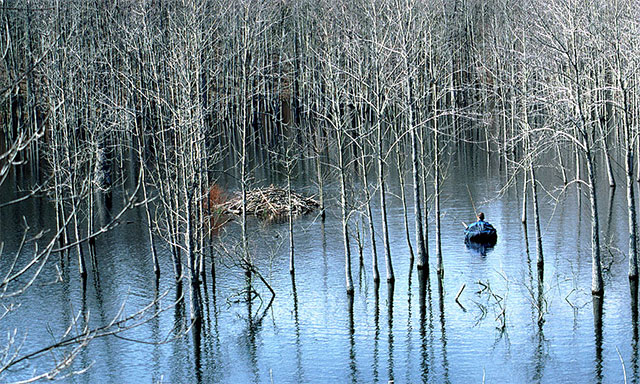Walleye Fishing Getting Into Gear Right Now
In early March, with water temperatures in the upper 40s, walleye can be found in river headwaters and in the tailwaters of reservoirs below dams.
This seasonal fishing opportunity is arguably one of the best times of the year to catch walleye. "In Lake Cumberland, walleye make spawning runs in February and March to the Cumberland River above the mouth of the Laurel River, and the Big South Fork arm of the lake above Alum Ford," said John Williams, southeastern fisheries biologist for the Kentucky Department of Fish and Wildlife Resources. "Up there, anglers fish jigs tipped with minnows. As they drift downstream, the jig is fished vertically and bounced off the bottom."
Williams said later in the spring in April, May and into June, walleye in the lake move up into the creeks. "It's amazing how shallow they can be, especially if the water is stained," he said.
It's not unusual for walleye to be in 4 to 5 feet of water around small sycamore trees and flooded brush growing right at the water's edge. A productive lure choice for this type of fishing is to drift a live nightcrawler on a spinner rig and bottom bouncer.
At nearby Laurel River Lake, the pattern is similar, with walleye in the lake moving deeper as the weather warms up. "Walleye move up shallow in coves in the spring and stay there until water temperatures climb in the 70s," said Williams. "In April and May walleye are in water that's less than 15 feet deep."
Walleye spend a lot of time around flooded timber, which is difficult to fish. Williams recommends fishing nightcrawlers on spinner rigs at the mouths of timbered coves late in the afternoons, when walleye move out into more open water.
Native to Kentucky, the walleye (Sander vitreus) is present today in six lakes, with fishable populations established through decades of stockings and intensive management.
The four other Kentucky lakes that have populations of walleye are Carr Fork Lake, Nolin River Lake, Paintsville Lake, and Green River Lake. Additionally, there are walleye in the tailwaters of these lakes and in the Ohio River.
Statewide, there's a 15-inch minimum size limit on walleye and a six fish daily creel limit.
"A majority of the walleye in the Green River Lake tailwaters are fish from the lake," said Eric Cummins, fishery biologist in the southwestern district, for Kentucky Fish and Wildlife. "There are no screens on the discharge outlet pipes of the dam, so walleye of all sizes come through the dam into the tailwaters."
Typically, walleye escape when the lake is down in the winter and there's a sudden rise due to heavy rains or snow melt.
Jigs and curlytail grubs are top lure choices when fishing in the tailwaters, Cummins said.
"In the lake when we are electrofishing in mid-to-late winter, we sometimes find pre-spawn walleye that have moved up into stained water on flats," said Cummins. "By mid-March there are usually walleye on rocky banks and around islands."
In late April, May and into early June, the lure of choice is a spinner rig baited with a nightcrawler.
There's a lot to like about walleye. They thrive in cool water so their flesh is firm and tasty. The can grow to 30 inches in lakes and bite readily, when anglers learn where to find them and what the best presentation is when fishing lures or bait.
The walleye is distinctive in appearance. It has large, glassy eyes and a prominent dark blotch on the first dorsal fin. Coloration is dark green on the back. The yellowish sides have faint markings and the belly is milky white.
Sauger, which closely resemble walleye, are darker, with distinctive brown saddlelike markings across their back and sides.
In the 1960s, the early years of walleye restoration in Kentucky, fisheries personnel stocked the Lake Erie strain of walleye, which is more suitable to lake environments.
Restoration efforts intensified in the 1970s with the opening of the Minor Clark Fish Hatchery. At the cool-water hatchery near Morehead, Kentucky Fish and Wildlife biologists and technicians began producing walleye fingerlings spawned from broodstock collected in-state.
The walleye's geographic range extends from the Tennessee River basin northward, on both sides of the Appalachians, to Quebec and northwestern Canada.
Get out this spring and catch some walleye, one Kentucky's overlooked fishing opportunities.
Changes are in the Wind
What is Lure Presentation


